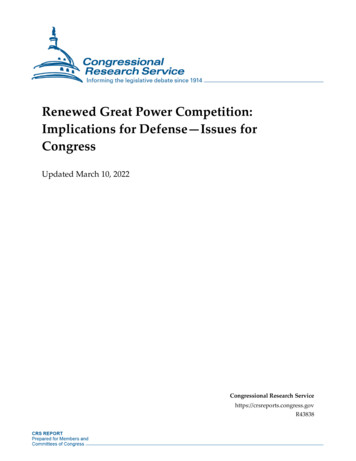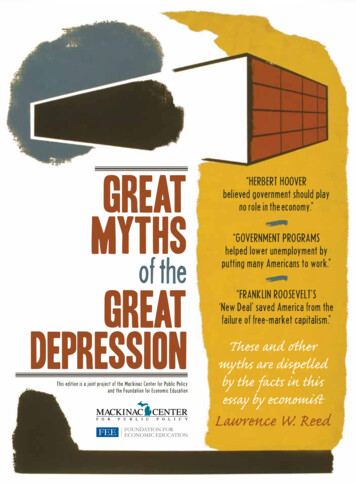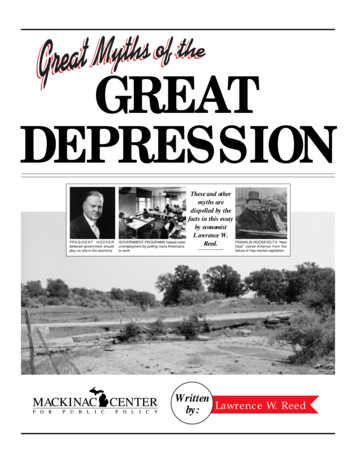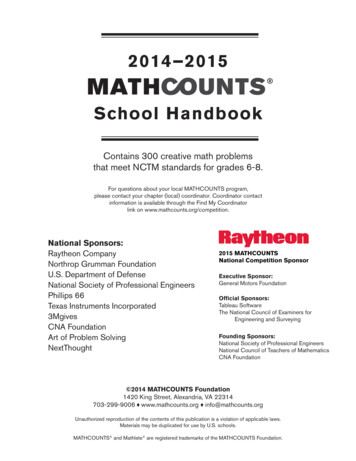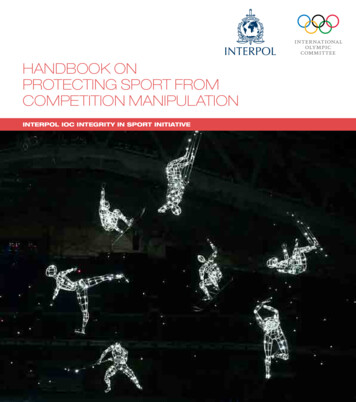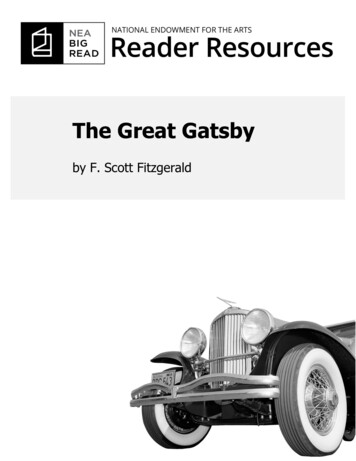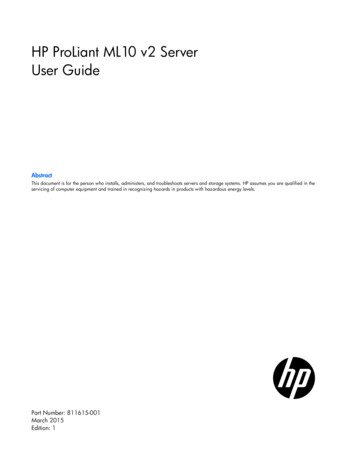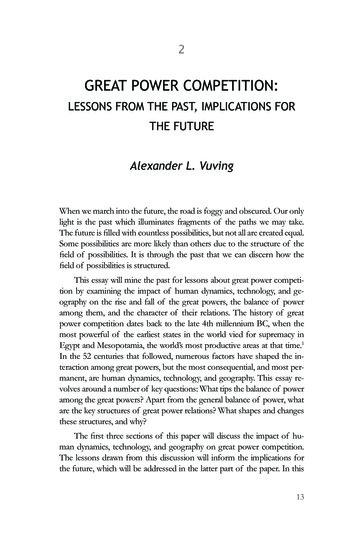
Transcription
2GREAT POWER COMPETITION:LESSONS FROM THE PAST, IMPLICATIONS FORTHE FUTUREAlexander L. VuvingWhen we march into the future, the road is foggy and obscured. Our onlylight is the past which illuminates fragments of the paths we may take.The future is filled with countless possibilities, but not all are created equal.Some possibilities are more likely than others due to the structure of thefield of possibilities. It is through the past that we can discern how thefield of possibilities is structured.This essay will mine the past for lessons about great power competition by examining the impact of human dynamics, technology, and geography on the rise and fall of the great powers, the balance of poweramong them, and the character of their relations. The history of greatpower competition dates back to the late 4th millennium BC, when themost powerful of the earliest states in the world vied for supremacy inEgypt and Mesopotamia, the world’s most productive areas at that time.1In the 52 centuries that followed, numerous factors have shaped the interaction among great powers, but the most consequential, and most permanent, are human dynamics, technology, and geography. This essay revolves around a number of key questions: What tips the balance of poweramong the great powers? Apart from the general balance of power, whatare the key structures of great power relations? What shapes and changesthese structures, and why?The first three sections of this paper will discuss the impact of human dynamics, technology, and geography on great power competition.The lessons drawn from this discussion will inform the implications forthe future, which will be addressed in the latter part of the paper. In this13
Hindsight, Insight, Foresight: Thinking about Security in the Indo-Pacificfuture-oriented part, I will focus on these major questions: Will great power competition continue in the future? What will perpetuate it, and whatwill arrest it? How do the key structures of great power relations shapethe hegemonic contest of our time? What strategies are critical to winningthat contest? Apart from the great powers, what emerging actors can causeprofound changes and disrupt the balance of global power in the comingdecades? I hope the discussion in this paper will light the path of greatpower competition for decades to come.Impact of Human DynamicsAs with any human community, the fate of great powers hangs in significant part on the decisions made by its members, individually or collectively.Although great powers are highly complex organizations, the major decisions to steer their course have often been concentrated in the hands ofa few people, much of the time even a single individual. As power wasconcentrated on a few people, their beliefs, personalities, preferences, andrelationships disproportionately affected the course of the state they ruled.The personal ambition of an empire’s founder invariably lay at the root ofthe empire’s rise and expansion, which was also contingent on his talent,leadership skills, and vision. These personal factors of his successors, theinfluence of their advisors, family members, and friends, and the relationsamong the ruling factions would continue to play a large role in the life—and death—of the empire.The concentration of power on a few is itself a universal human dynamic. Sometimes it reflects the attraction of leadership and the practiceof followership; sometimes it results from the coercive force of a few overthe many; sometimes it is maintained by a “social contract” in which therulers get more wealth and freedom in exchange for providing the ruledwith security and prosperity; oftentimes it is a confluence of all three. Thephenomenon of the great powers is itself the manifestation of this humandynamic at the international level. The more power is concentrated, themore it reflects the beliefs and desires, as well as the whims and caprices,of the powerful.14
Great Power CompetitionMany countries in the past were regarded as the real estates of their rulers orthe families of their rulers. As most people wanted to enlarge their own realestates, so did these rulers and their families. Sometimes, the cohesion andstrength of a great power diminished significantly because it was divided upamong the sons of its ruler after his death. This was the case, most glaringly,with the Carolingian empire and the Mongol empire. Sometimes, severalcountries were merged into a larger one through the marriage of their rulers. The emergence of Spain as a great power has its root in the marriage ofQueen Isabella I of Castile and King Ferdinand II of Aragon (1469). A marriageof their rulers also united the Spanish and Portuguese empires in the IberianUnion (1580 – 1640). Marriage was the main way through which the Houseof Habsburg expanded their holdings and knit together the largest power inEurope during the 15th and 16th centuries.The belief that a country is the property of its ruler, although widespread, was a specific case among the different beliefs about the right toown a land and the right to rule a people. These and other belief systems,which we call ideology, religion, superstition, or science, were indispensable and impactful in guiding the thoughts of people—rulers and ruledalike—on almost everything. Apart from its thought-guiding function,ideology (called religion when tied to one or more gods) always played animportant role in beefing up and breaking up the cohesion and strengthof the states in general and the great powers in particular. When the Arabs defeated both great powers of their time, the Persian empire of theSassanids and the Byzantine empire, and created a new great power, theRashidun Caliphate, they relied not only on the superiority of their militarytactics and the talent of their generals, but also on the religious fervor oftheir combatants, the religious difference between the rulers and the populace of the Persian empire, and the religious oppression of the Byzantineempire against many of its citizens in the Levant and Egypt.2The Arabs provide a glaring example not only of the impact of ideology but also of who I will call “system-changers.” Examples of systemchangers abound throughout the history of the great powers.315
Hindsight, Insight, Foresight: Thinking about Security in the Indo-PacificSystem-ChangersThe Amorites, the Hurrians, the Kassites, the Phrygians, and the Aramaeans(21st – 11th centuries BC). Their nomadic lifestyle and tribal structures madethem superior in terms of mobility and flexibility to the great powers of theirtime. Their migrations, infiltrations, and invasions led to the collapse of thosegreat powers, but most adopted the civilizations of their adversaries afterward.The Amorites and the Hurrians later founded the ruling dynasties of three greatpowers: Assyria, Babylon, and Mittani. The language and alphabet of the Aramaeans became the common tongue of the Middle East by 500 BC.The Yuezhi (Tokharians) and the Sakas (which meant “nomads” in Iranian).When these Indo-Iranian steppe peoples fled westward and southward in the2nd and 1st centuries BC, they effectively merged the two hitherto independentsystems of states, one in the Mediterranean, the Middle East, and the Indiansubcontinent and another in East Asia, into a single system that included allstates in the world at that time. The expansion of the Xiongnu drove the Yuezhiwestward, who in turn pushed the Sakas southward. A branch of the Yuezhi settled in Bactria and founded the Kushan empire, which in its heyday in the 2ndcentury AD stretched from the Aral Sea to the Indian Ocean and was one of thefour great powers of that time, together with the Roman Empire, the Parthianempire, and the Han empire.The Germanic peoples, most notably the Visigoths and the Vandals (4th – 5thcenturies). Their rebellions and invasions contributed heavily to the collapse ofthe Western Roman Empire. Many of these people had been embedded in theRoman Empire as foederati (treaty-bound allied people), though their loyaltyultimately lay with their kings and nobles. Treated unfairly by the Romans, theyrevolted, led by the Germanic elements of the Roman Army, and founded newGermano-Roman states on the soil of the Roman Empire.The Vikings and the Normans (9th – 12th centuries). These Nordic peoples excelled in mobility as sailors and founded several kingdoms scattered from theAtlantic to the Mediterranean. Their migrations were generally led by a coalitionof warlords and individuals seeking opportunities for themselves and their followers. It was rare for a Norse or Norman head of state to lead an invasion, suchas the case of William the Conqueror’s invasion of England. This flexibility inleadership, combined with a nearly unmatched naval ability, allowed the Nordicpeoples to severely hinder both the Byzantine and Carolingian empires, displacethe Khazars as the dominant traders in the Pontic steppes, and establish numerous colonies from Greenland to Antioch.Various Turkic groups such as the Pechenegs, the Oghuz, and the Karluks (10th– 11th centuries). Their migrations, military campaigns, and involvement in political affairs of the states they served massively disrupted the balance of powerin the Middle East, Eastern Europe, Central Asia, and the Indian subcontinent.Among their exploits was driving the Byzantines out of Anatolia, embeddingthemselves in the Caucasus, toppling Persian powers such as the Samanids andAbbasids, and introducing Islam into Northern India. Their success can be attributed to their mobility and military excellence. Another advantage was theprevalence of Turkish mamluks in military positions, which allowed them tostage coups and revolts such as the Ghaznavid takeover of the Samanid empire.16
Great Power CompetitionSystem-Changers (continued)The European adventurers, most notably the Spanish conquistadors, the Portuguese traders, and the Russian pioneers (merchants, Cossacks, peasants), inthe 16th – 17th centuries. While seeking fortune for themselves, they acquiredterritory in service of their state. Although many adventurers held strong ties totheir sovereign, the limited communication between the two parties gave theadventurers significant leeway in their actions. The Portuguese displaced theArabs as the dominant traders in the Indian Ocean and fundamentally changedwarfare and politics in Japan during the critical Sengoku period. The conquistadors toppled both the powerful Aztec and Incan empires, while the Cossackspushed Russian sovereignty as far as Kamchatka and warred with the Qing empire and various Mongol successor states.The British East India Company, a joint-stock company with close ties to theBritish government. The company’s private army in the 18th century played alarge role in conquering India, thus securing monopoly trade rights for the company. The company governed the conquered territories until the Regulating Actof 1773. In the mid-19th century, the company was a driving force behind thetwo Opium Wars that marked the beginning of what the Chinese later calledtheir “century of humiliation.”The Islamic fundamentalists in the late 20th and early 21st century (to be addressed below).What these diverse communities, movements, and organizations havein common is that more than the secondary states in the internationalsystem, which have to take the system as it is, they are able to change the system, thanks largely to the extraordinary dynamism of their quest for opportunities, but less than the great powers, they are, for the moment, stillunable to make the system, i.e., to stabilize it. Some, such as the Kushansand the Arabs, quickly crossed the threshold to become system-makersby building empires or influential states of their own. Others, such as theconquistadors, the Russian pioneers, and the British East India Company,engaged in a close relationship with a sovereign state to obtain government sanction and support. While they maintained a considerable roomfor independent actions, they were often the frontier forces that expandedthe sphere of influence, even the territory, of their sovereign. Still others,such as the Amorites and the Kassites, captured existing states, replacedtheir ruling elite, and changed the character of these states.In the post-Cold War period, when the United States remained theworld’s sole superpower, a debate broke out among scholars of international relations about the longevity of this unipolarity. Skeptics argued that17
Hindsight, Insight, Foresight: Thinking about Security in the Indo-Pacificit would not last long because sooner rather than later other major powerswould gang up against the hegemon.4 Believers contended that America’sglobal hegemony was there to stay because the immense power gap between the United States and the next biggest powers would both discourage and thwart any attempts at balancing it.5 As it turned out, the skepticswere somewhat right in their conclusion—U.S. unipolarity did not last longer than a quarter of a century—but wrong in their reasoning—the onlyweighty anti-American coalition was that of China and Russia, but this arrived late toward the end of the unipolar period.6 Both sides of the debatemissed the mark because they ignored the role of the system-changers.The September 11, 2001 attacks on the Twin Towers in New York andthe Pentagon by Islamic fundamentalists changed the world in an enormous way. The Bush administration immediately turned to a “global waron terror,” which would consume much of Washington’s foreign policyattention, energy, and spending for more than a decade. In the 15 yearsfrom 2001 to 2016, China, which presidential candidate Bush characterized as early as 1999 as the “strategic competitor” of the United States,7enjoyed what its leaders recognized as a prolonged “strategic opportunity”during which it was able to quadruple its economic output, catapult fromthe sixth-largest to the second-largest economy in the world, and turn theSouth China Sea into a chokepoint it can control by building several largeartificial islands on disputed reefs in the middle of the sea.8Human dynamics that are highly consequential to great power competition often come in three forms. First, some actors that have previouslybeen at the margins of the system or not even existed—the “new kids onthe block”—now bring in enormous new energy created by their superiormobility, ideological fervor, or economic resources. Second, some actorsget ahead of others due to major innovation in military technology andgovernance organization. Third, some actors acquire a vast amount ofknowledge and skills by learning from the most advanced and from experiences of the past, and by integrating aspects of other cultures, which arebeneficial, into their own. These new energies, innovations, learning, andintegration invariably lie at the root of the rise of new great powers. Onthe other hand, great powers that lose energy, lack major innovations, andfail to learn from others and integrate new cultures are bound to diminish.Impact of TechnologyTechnology has two chief structural effects on great power competition:it can tip the balance of power and it can change the structure of the18
Great Power Competitionstrategic game among the great powers. Technology is one of the few underlying factors that distinguish great powers from lesser states. Withoutsuperior technology, no actor can become a great power. However, rarelyhas the edge in a single technology tipped the balance among the greatpowers. One reason for this is the rapid diffusion of technology. Whengreat powers are in intense competition with one another, a newly innovated and applied technology is quickly learned once it demonstrates someadvantage. As a result, being the innovator of a major technology does notguarantee superiority; sometimes a quick learner who adds smaller innovations in accessories can beat the first innovator.When technology tips the balance among great powers, what makesthe difference is often one or more clusters of related technologies supported by socioeconomic and organizational factors. As warfare has oftenbeen the ultimate arbiter of success in international relations, besides themore general issues such as morale, communication, and logistics, greatpowers usually had to compete for higher mobility, firepower, and defenseof military forces. The chariot, the sling, the composite bow, the horsesaddle, the saddle stirrup, and the various types of armor had greatly enhanced these abilities in the agricultural age. So did their successors in theindustrial age: the nuclear warhead, the cruise missile, the ballistic missile,the combustion engine, the submarine, and the missile defense system.Missile superiority can sometimes shift the balance between great powers,but what constitutes missile superiority is a combination of technologicalinnovation, a robust economic base, and organizational prowess.Perhaps the largest impact of technology on great power competitionis that of nuclear weapons. They can change the structure of the strategicgame between states and with it, the best strategies for the players and thestable outcomes of the game. Nuclear weapons do so by helping peopleto exceed the “overkill” threshold.Prior to the nuclear age, most great powers saw their own predominance as the best option, their own subordination as the worst, a divisionof power as the second-best, and war as the second-worst, or third-best,option. We can express this preference order as P D W S, where Pstands for predominance, D for division of power, W for war, and S forsubordination. When two players having this preference order engage ina strategic competition, they are locked in a situation called “prisoner’sdilemma.” This situation has a distinctive structure that renders the beststrategy for each player invariably to “defect”—to pursue its self-interestregardless of whether the opponent will cooperate or not. This strategy19
Hindsight, Insight, Foresight: Thinking about Security in the Indo-Pacificcorresponds with the stable outcome of the game, called “Nash equilibrium” after the mathematician John Nash, who has shown mathematically how the structure of a strategic game dictates the best strategies forthe players and determines the stable outcomes of their game (Nash wasawarded a Nobel Prize in economics 40 years later for this work). Thestable outcome of the prisoner’s dilemma, its only Nash equilibrium, iswar when the players are competing great powers. The Greek historianThucydides’s comment on the war between the hegemonic contenders ofhis time and place, “It was the rise of Athens and the fear that this inspiredin Sparta that made war inevitable,” was a 5th-century BC statement of theprisoner’s dilemma’s Nash equilibrium.9The structure of the prisoner’s dilemma hinges on a key perception:nothing, including war, is worse than subordination. This perception wasprevalent among the great powers of the past; indeed, the subordinatedwas guaranteed to lose everything most valued in life: honor, wealth, independence, freedom. Nuclear weapons upend this perception. Becauseof its “overkill” effect, war between nuclear-armed states can be worsethan subordination. An all-out nuclear war between two great powers candestroy both. This perception structurally transforms a hegemonic contestfrom a “prisoner’s dilemma” to a “chicken game.”In a great power competition structured as a chicken game, the bestoption for the players remains their own predominance and the secondbest option a sharing or division of power, but the worst option is war andthe second-worst, or third-best, option is subordination (P D S W).With the structure of the game transformed, the best strategy and stableoutcome of the game are also changed. The most striking difference between the prisoner’s dilemma and the game of chicken is the reverse oftheir stable outcomes. If war is inevitable in a great power competitionstructured as a prisoner’s dilemma, peace is equally attainable in a greatpower competition structured as a game of chicken. There are three Nashequilibria in the game of chicken, corresponding to three stable outcomesand three sets of best strategies for the players.10 A game of chicken between two hegemonic contenders may result in either a division of powerthat both contenders more or less honor or the predominance of one ofthe contenders. The first hegemonic contest of the nuclear age, the “ColdWar” between the Soviet Union and the United States, was so dubbed because it did not involve open warfare between the two great powers. Conforming with the Nash equilibria of the chicken game, the Cold War tookthe form of an extremely tense but relatively stable division of Europe, its20
Great Power Competitioncentral theater of contest, throughout the conflict and eventually resultedin U.S. hegemony when the Soviet Union imploded.Recently, Professor Graham Allison of Harvard invoked Thucydidesand coined the term “Thucydides Trap” to describe the inclination to warof great power competition. He raised the specter of war between thetwo hegemonic contenders of today and asked, “Can America and Chinaescape Thucydides’s trap?” But his thesis is misplaced at best because itis based on a fundamentally flawed assumption. It assumes that all cases of great power competition share a similar structure as illustrated byThucydides’s famous quote about the inevitability of war between Athensand Sparta. Hence it posits the existence of the Thucydides Trap wherethis does not exist: in games of chicken (P D S W) such as the strategicrivalries between Portugal and Spain in the late 15th century and betweenthe United States and the Soviet Union in the 20th century, in the “calledbluff ” game (a combination of the game of chicken and the prisoner’sdilemma) between Britain and the United States in the early 20th century,and in the “concord” game (D P S W) between Britain/France andGermany in the 1990s.11 Yet, these “peace” cases are treated as anomalies in the Thucydides Trap thesis, while the “war” cases are regarded asnormal.12 In light of the strategic game structure, however, the “no war”outcomes of these rivalries are predicted perfectly by their Nash equilibria.The risks of war still exist in the games of chicken, but they lie in human errors, machinery defects, or other non-structural factors, not in theThucydides Trap.EscalationSpartaGame of ChickenP D S risoner’s DilemmaP D W SNashEquilibriumEscalationU.S.A.Figure 2.1. Strategy and Outcome of Great Power Competition21
Hindsight, Insight, Foresight: Thinking about Security in the Indo-PacificImpact of GeographyNuclear weapons are not the only factor that can transform a prisoner’sdilemma into a game of chicken. A contested region far from the corearea of a great power can make this contender perceive the cost of subordination in that region smaller than the cost of war, especially if war canreach the core area. This perception—that war is worse than subordination—renders the competition over a remote region a game of chicken(P D S W), not a prisoner’s dilemma (P D W S). The hegemoniccontest between Portugal and Spain over the non-Christian world in thelate 15th and early 16th centuries was a game of chicken because bothgreat powers competed for areas far from their home territories and stilllargely unknown to them. The competition between the United States andthe United Kingdom for supremacy in the Western Hemisphere in thelate 19th and early 20th centuries was an asymmetric game, named “calledbluff ” by game theorists, in which Britain played chicken because thecontested site lay far from its home while America played the prisoner’sdilemma because Washington was ready to wage war to assert its primacy.Predicted by their Nash equilibria, both rivalries resulted in agreements onspheres of influence.Like technology, geography can elevate a state into great power status, tip the balance of competition, and change the structure of the gameamong great powers. But if technology can be a great equalizer, geographyis a great un-equalizer. In the geography of Earth, all places are createdunequal given their different climates, terrains, resources, and locations.Throughout history, a few places were privileged by these and other factors such as human dynamics, technology, and timing to become the seatsof great powers. Uruk, Tjeni, and Magadha, the first great power in Mesopotamia, Egypt, and India respectively, each combined a fertile hinterlandand a strategic crossroads of important trade routes. Macedon, Qin, andlater, Britain and America shared a similar characteristic: they were supported by a relatively large and resource-rich region and, at the same time,protected by relatively insurmountable geographic barriers—distance, sea,or mountains.On a larger scale, the Eurasian continent and its adjacent regions inthe North Atlantic, North Africa, the Indian Ocean, and the Western Pacific are geopolitically privileged over Earth’s other landmasses. Its big sizeand the diversity of its terrains and climate zones, amplified by its eastwest orientation, have endowed its inhabitants with more resources, great-22
Great Power Competitioner immunity to pathogens, and better chances of development, as JaredDiamond has vividly described in his book Guns, Germs, and Steel.13 Thelargest among the areas of intense human interaction on Earth, GreaterEurasia was the seat of all great powers throughout history until the riseof the United States at the turn of the 20th century.From a geopolitical perspective, Greater Eurasia consists of a heartlandat its continental core, a rimland that stretches along its western, southern,and eastern seaboards, and some offshore islands such as Britain, Japan, andJava. The primary strategic edge of the Heartland was the superior mobility provided by its steppes and the horse native to this area. However, theHeartland lacked the fertile alluvial soil and the right climatic conditionsthat made a few Rimland regions—the valleys of the Nile, Euphrates, Tigris, Indus, Ganges, and Yellow River—the birthplaces of the first civilizations and great powers. Throughout history, the Rimland boasts the largestnumber of inhabitants, production centers, and major powers on Earth.One reason for the productivity of the Rimland is that it has enough waterto support life on a very large scale. The productive areas of the Rimlandhave repeatedly given rise to great powers—Egypt, Assyria, Persia, Rome,India, and China, to name a few—but each remained the hegemon in itsown region and never became a global hegemon.In order to dominate all of the Rimland, one must gain direct accessto each of its productive areas, to Europe, the Middle East, India, andChina. This geographical imperative gives the hegemonic power of thesteppe zone that spans the south of the Heartland from east to west andthe hegemonic power of the world’s oceans a clear edge over any regionalhegemon in the Rimland. The largest contiguous state ever known was theMongol empire, a great power based in the Heartland which achieved itspartial hegemony over Eurasia thanks partly to its central geographic position and the mobility and formidability of its military, both enabled by theHeartland. But the largest state by land area the world has ever had was theBritish Empire. Based on a large offshore island of Europe, it controlledmost of the world’s maritime trade routes and dominated the world’soceans, which served as the backbone of its global empire. The Cold Warbetween the Soviet Union and the United States was a direct match of fullstrength between the hegemon of the Heartland and the hegemon of themaritime domain. The United States emerged victorious from this contestnot least because of its favorable geography, which endowed it with a better climate, better protection, and better access to the sea. With direct access to and protection by both the Atlantic and Pacific Oceans, the United23
Hindsight, Insight, Foresight: Thinking about Security in the Indo-PacificStates was “the most favored state in the world from the point of view oflocation,” as Nicholas Spykman noted on the eve of World War II.14 Spykman had refined Halford Mackinder’s original idea about the configurationof Earth and developed the concept of the Rimland in conjunction withthose of the Heartland and the Offshore. His insights, succinctly summarized in the dictum, “Who controls the Rimland rules Eurasia; who rulesEurasia controls the destinies of the world,” would inform much of theU.S. grand strategy in the Cold War, the “containment” strategy.15Offshore powers draw their advantage from the ocean: it provides superior protection and, since the invention of ocean-going ships, supremeconnectivity. Like a unified network of gigantic rivers that connects theworld’s most productive areas, the world’s oceans created, before the agesof airplanes and the Internet, the global system of transportation and isstill the backbone of this system even when the transportation of goodsand data can take place in the air, space, and cyber domains. This advantage of the maritime domain was graphically captured by Alfred Mahan,the author of The Influence of Sea Power upon History 1660-1783, in an early20th-century debate with Halford Mackinder, the originator of the ideathat the “geographical pivot of history” was the Heartland: “As a highway,a railroad competes in vain with a river—the greater speed cannot compensate for the smaller carriage.”16The geographic configuration of planet Earth has a profound impacton almost everything in the biosphere. It dictates the distribution of habitats for animals and plants and constrains the chance of development fornations.17 At the geopolitical level, it suggests the seats of great powers andshapes the propensity of great power competition. The specific configuration of land an
Sep 02, 2020 · sions to steer their course have often been concentrated in the hands of a few people, much of the time even a single individual. As power was concentrated on a few people, their beliefs, personalities, preferences, and relationships disproportionately affe
